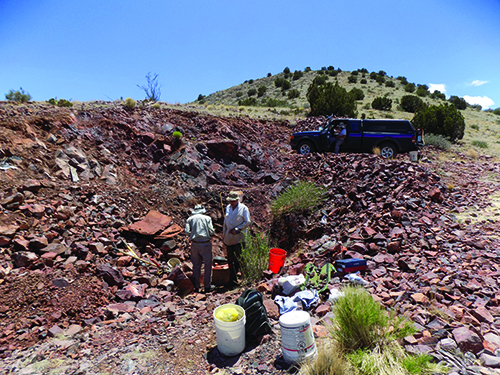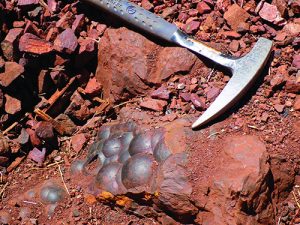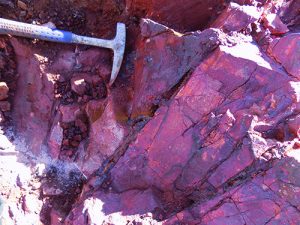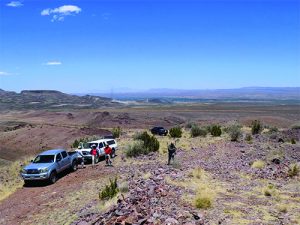
By Mark Leatherman
My account of my first major New Mexico rockhounding venture appeared in the November 2017 edition of Rock & Gem. After that trip of collecting a nice load of smithsonite, blue fluorite, galena, linarite, and much more, I was addicted to all the state has to offer.
When Gary Rowe, of the Colorado Mineral Society, put on this exodus again a year later, there was no thought required! Not only was I looking forward to getting underground at the Blanchard Mine again, I was giddy about a place that was new to me: the U.S. 60 Mine west of Socorro, known for its botryoidal hematite and goethite.
The route towards this mine was familiar, as this was the same path to get to the famous Kelly Mine for its smithsonite. Unlike my previous trip, this trek only took around 15 minutes from where we pulled off the namesake highway to meet the claim owner and well-known Socorro collector, Alan Perryman. After carpooling a short but rough drive up a lofty way, we had arrived at a small but steep workings pit with a significantly bigger tailing pile nearby. Despite the small size, everyone found a comfortable spot and was ready to work hard for the heavy metal treasures.
Portable Tools Aid in Extraction
The primary challenge in extracting specimens here is the very hard rhyolite matrix. As such, Alan was kind enough to haul up an electric chisel tied to a portable generator for our group. Although small plate specimens can be won by hand tools, the power tool was a wonder and a ton of fun to use as well. Throughout the course of the day, everyone got in a couple of passes and no one left empty-handed!

(Mark Leatherman)
Another challenge is the inherent nature of this hematite. Not only is it hard, but quite prone to fracturing. I won most of my finds from the upper shelves of the pit, with most plates present below 4”. I also recovered several excellent and thick vug pieces. Although not found on that day, pockets of small hyalite (colorless) opal have also been found.
With Gary having been to this pit multiple times, he and Alan occupied most of their time at the very bottom of the pit. This was due to the presence of a very large plate of botryoidal hematite around 2’ long and 1’ thick. It turned out that they have been attempting to remove the plate intact for the better part of two years. No matter how many helpers assisted, or how big the electric chisels were, it was still ground-bound at the end of my visit. However, not all efforts were in vain, as a small seam of gemmy quartz vugs in the hematite were had, and everyone left with a good specimen.
‘Blueberries’ Amid Stalactites
When early afternoon hit, I made my way over to the nearby tailings mound to hunt with Gary’s son, John, who was having luck finding miniature stalactite-form specimens. Before I could hunker down, John advised me of a rattlesnake sighting down one side of the pile. After picking a spot well away from the sighting, I was readily finding specimens simply by turning over rocks. Alongside the stalactites, both of us found more uncommon “blueberries.” In this case, they are tiny (smaller than BBs) oolitic hematite concretions that form on top of the former crystal habit. After filling up a small plastic bag with these beauties, the heat was starting to bear down, and it was time for some of us to head in that same direction.
The botryoidal hematite and goethite deposit is a part of the larger San Luis Manganese District that is housed in the Magdalena Mountains, southwest of Socorro.
The mountains are part of the Rio Grande Rift that started extension about 30 million years ago and continues today. Continental rifting, or extension, divides the affected section of the crust into alternating mountains and valleys (or horsts and grabens, respectively). The area host rocks are dominantly rhyolites, dacites, and ash tuffs associated with explosive volcanic activity related to the rifting that dates back approximately 30 million to 15 million years. Dateable cryptomelane, a form of manganese oxide, suggests hydrothermal mineralization of the district occurred between 4-7 million years ago.
The botryoidal nature of the hematite would suggest that mineralization commenced around small growth nuclei (or seeds) such as sand or dust, with radial growth occurring equally in all directions. However, Earth is always full of surprises!
Gravity Defying Formation
Most hydrothermally formed stalactitic goethite and hematite are typically cylindrical stalactites, similar to those that calcite and aragonite form in caves. Under the influence of gravity, stalactites grow from the ceiling down when mineral-rich water slowly drips down, and the dissolved minerals accumulate developing a stalactite (similar to icicles). The growth of this habit is due to being in a delicate, yet stable, environment with constant temperature and humidity, for thousands of years. This created an atmosphere ripe for slow, uninterrupted formation. However, stalactites have a “crazy” cousin known as helictites, which seem to defy gravity. Helictites typically start out as very small stalactites and then proceed to curve around in any which way, including back up. Yet, these funky formations do not have a universally accepted mode of formation yet, but there are multiple theories.
In normal calcite-aragonite caves, some have suggested that cave winds could move around the suspended drops of solution to influence growth in another direction. Although there are wind caves, like the namesake national park in the Black Hills of South Dakota, winds inside are influenced by outside weather. Thus, cave winds are not likely to remain constant for centuries that would allow such nice crystal growth.
Additionally, most helictite-bearing caves or mineralizing vugs do not have a natural

opening where atmospheric winds could enter. Somewhat related to the wind theory of helictite growth is one where the formation is due to slight pressure changes. With this, a slow change would apply stress on a stalactite precipitation front, move it, and crystals would start to grow under a new orientation. Another theory is the influence of bacterial activity, which is supported by the observation that a prokaryotic bacterial film provides a nucleation site for the mineralization process. However, the most prevalent theory involving helictite growth is centered on capillary forces.
In short, capillary forces describe the upward movement of fluids through a tube (think of sucking on a straw, or how trees get water from their roots). Capillary forces are dependent on the strength of attraction between the spaces of molecules coupled with gravity (think of this as an up-and-down tug-of-war of atomic scale attractions). If tiny stalactites start out hollow, then mineralizing fluids could travel upward (like the straw example) and appear to grow against gravity. Such habits that start out as growths on a floor, rather than a ceiling, are known as helictites.
Unusual Formations
Although the hematite and goethite found at the U.S. 60 Mine are not hollow, the iron-mineralizing fluids could be viscous (thick) enough to still support growth in “zero gravity.” As such, helictite growth formation is still very enigmatic no matter what minerals are involved!
According to Alan, 15 years of collecting goethite and hematite at this location has yielded plenty of unusual stalactitic and possible helictite formations. In one specimen he collected, there were two stalactites that from the top down formed a “V” shape approximately 1/2” in length and a 1/2” apart across the top.
Also, there are two more stalactites approximately 3” away from each other, and they both grew at a 90? orientation from the downward forming “V”-shaped stalactites. So, these two stalactites are pointing towards you when the “V” is pointing downward.
A different example involves a 1/4” diameter by 1” long stalactite that curved in its development. Another rare deviation of goethite is conical shaped stalactites, compared to the more common cylindrical shape. During crystal growth, it is possible to start growing a cylindrical habit and switch to a conical form due to a slight change in mineralizing fluid chemistry. This allows for newer-formed crystals to fit into the mold of crystals formed before (think of stacking ice cream cones upside-down). The exact mechanism for this is unknown, but given the similar, yet different, chemistries of hematite and goethite (Fe2O3 vs. FeO(OH)), this is very plausible.
Quick Cooling Following Hydrothermal Event
During the development of this deposit, the hydrothermal solution, or slurry, of goethite flowed and squirted into cracks and crevasses of the host rhyolite. It is thought that the hydrothermal event(s) was abrupt and explosive as the goethite splattered into the openings and onto the roof and walls of the fissures within the rhyolite. The combined solution of hot water and dissolved goethite originated approximately six miles below the surface.

(Mark Leatherman)
This hydrothermal event needed a very high quantity of steam and hot water pressure to force the goethite solution to the surface of the hillside. After the hydrothermal event, the goethite cooled on the surfaces of the rhyolite and developed the varieties of goethite including botryoidal, reniform, oolites, cylindrical and conical-shaped stalactites, stalagmites, tuberose, and helictites. Presumably, the formations of goethite only took days or weeks to cool and develop as opposed to the thousands of years needed for limestone caves to develop calcite and aragonite helictites.
Both clubs and individuals can visit the mine with no set limit on how much material can be taken out. The only three things that Alan requests are at least a week’s notice given before visiting, be respectful of the environment, and be ready to work hard for your finds. Due to the dirty nature of this deposit, it is recommended to wear older clothes that could potentially be thrown away.
For more information, contact Alan Perryman at altperr@yahoo.com.















